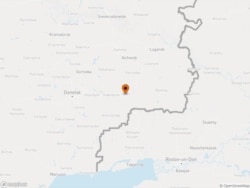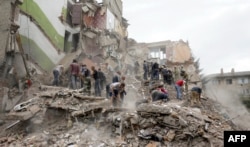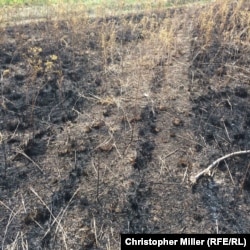KYIV -- Visible over the wheat stalks, a small sedan was barreling down the bumpy road toward us.
I remember the face of my journalist colleague, Roland Oliphant of The Telegraph newspaper, going serious and him saying something like, "These look like soldiers."
I responded with something along the lines of, "Let's get our story straight."
When the beat-up vehicle came to a screeching halt beside us, three or four armed men in camouflage fatigues -- fighters with the Russia-backed forces holding part of the Donetsk region in eastern Ukraine -- stepped out.
As if the maneuver had been practiced a thousand times before, they simultaneously lit cigarettes, thrust their Kalashnikov rifles over their shoulders, and shouted a command I had become so accustomed to hearing while covering the war in the Donbas that it had even infiltrated my dreams: "Documents!"
It was July 21, 2014, and we were on the outskirts of Snizhne, a small city 20 kilometers from the Russian border, on a hunt that Roland likened to searching for a needle in a wheat field.
But that might make it sound easier than it was -- and certainly safer. We were actually searching for a missile launcher, or traces of one, in a wheat field surrounded by scores of other wheat fields in the heart of an intensifying war zone crawling with trigger-happy fighters who were no fans of nosy foreign journalists.
To be precise, we had hoped to locate the exact site where Russia-backed forces fired the missile that shot Malaysia Airlines flight MH17 out of the sky four days earlier, killing all 298 people on board -- an event that shook the world and marked a turn for the worse in the war, whose toll has now reached 13,000. The Dutch-led investigation has concluded it was fired from a Buk missile launcher that had been brought in from Russia and was spirited back across the border shortly afterward.
What we told the gunmen who stopped us, however, was that we had simply gotten lost -- a seemingly harmless mistake -- while looking for the place where the plane had crashed after falling 10,000 meters.
The fighters' eyes narrowed as they scanned our documents, noting aloud our nationalities -- American and British. After pointing us north in the direction of Torez, the city closest to the crash site, they drove away.
We stayed and continued our search.
A Blog And A Hunch
Roland and I came to find ourselves trudging through the wheat field after planning the excursion the evening before in our hotel rooms in central Donetsk, the regional capital that was and remains the stronghold of the Russia-backed separatists.
Like the scores of other reporters who descended on eastern Ukraine in the aftermath of the downing of MH17, we had spent the previous four days reporting from the crash site, which was spread across three villages about 100 kilometers east of Donetsk.
But there were few clues there to one of the biggest unanswered questions about the disaster: Where was the missile that brought down the plane fired from?
As the sounds of shelling rumbled through Donetsk, we pored over a post on a blog called Ukraine@war -- since renamed Putin@war -- that caught our attention.
In the post, an amateur open-source analyst who uses the pseudonyms DJP3tros and Peter Martin claimed to have narrowed the possible launch site to three locations in a relatively small area southeast of Snizhne, based on a photograph of the missile's vapor trail that was first posted to Twitter by user @WowihaY and was promoted by Ukraine's security services.
His findings seemed to align closely with the movement of the Buk missile system traced by Eliot Higgins, the open-source analyst who founded the investigative group Bellingcat, using dashboard-camera footage and satellite images.
It would be a long shot, but with an early start and a smaller area to search than previously thought, we had a hunch we might just get lucky.
The Farmer And His Scorched Field
We set off early in the morning with a local taxi driver in a dilapidated car, hoping to keep as low a profile as possible.
Heading east from Donetsk, down roads cratered by artillery shells, we passed checkpoint after checkpoint where jumpy fighters scrutinized our documents -- passports, press cards, and special accreditation given out by the Donetsk separatists.
Beyond the city limits, the road and fields opened up and a feeling of uncertainty washed over us. Deep in the heart of separatist-controlled territory, a lot could go wrong.
A couple of hours later, we pulled into Snizhne, a depressed coal-mining city where anti-Western sentiment was prevalent and a Ukrainian air strike that had hit an apartment building and killed several people two days before MH17 was downed had further stirred passions.
After driving through a labyrinth of cottages, we came to a dirt road that led to what had been a collective farm in the Soviet era, when Ukraine and Russia were parts of the same country. This was one of the locations noted in the blog post that aligned with the MH17 crash site and the smoke trail photo.
There, we found three very surprised men, covered in dirt and grime, working in a garage. They said they hadn't seen anything, though they were there when the plane was shot down. They declined to say anything more.
We left our taxi then and huffed it on foot through the wheat fields. We didn't get far before the car full of fighters rolled up and stopped us briefly.
As they drove off, Roland noticed a large combine harvester cutting its way through the field a few hundred meters to the east.
Behind the wheel, we met Vasily, a local farmer. Years of hard work under the sun had carved deep crevices into his tanned skin, while the noisy combine engine left him hard of hearing.
He was working right in the middle of another possible location pointed out in the blog. Looking northwest from the spot, which rose slightly from the surrounding landscape, was a clear view of MH17's flight path. I remember feeling a rush of adrenaline that made my neck go cold in the summer heat.
But then Vasily said he had neither heard nor seen a missile launch nearby. "I can't even hear the shelling when I'm in the cab," he told us.
One thing struck him as odd, however.
"The field down the way was burning the other day. I don't know why," he said. "You might have a look there." He thought it happened on July 17 or 18, he added.
We drove the car down a tractor-worn path eastward across the field about a kilometer, in the direction of the villages of Chervoniy Zhovten and Pervomayskiy, keeping a close eye on the northwestern horizon. Then we pulled around a thin tree line and stopped the car.
"This has to be it," I said. The burned area was unmistakable and in any other circumstances perhaps unremarkable. But in the context of MH17, it seemed as close to a smoking Buk as we were going to get.
The longer we were there the more it felt like we'd found what we were looking for. The area was crawling with soldiers and we could hear an intense battle raging at Savur Mohyla, a strategic hilltop to the south. Roads to and from Russia were on either side of us, yet the tree line provided the perfect cover to hide behind.
Roland said, "If you wanted to fire a missile at a plane flying from that direction" -- gesturing toward the MH17 crash site north of Torez -- "then this would definitely be a good place to do it."

We scoured the blackened, oddly shaped area. As Vasily suggested, it didn't look like any ordinary crop fire. Numerous track marks ran near it and through it, along with detritus that suggested a group of people had idled there: discarded water bottles, beer bottles, and cigarette packs with Russian labels.
I photographed the area and filmed a short video of Roland walking around. We stuck around for probably a couple of hours, scratching our heads over how exactly the shoot-down might have taken place and how we could prove that it started right here.
And then the fighting over at Savur Mohyla grew louder and closer, and we knew we had a long drive back to Donetsk still ahead before dusk when the checkpoints closed.
We got back in the car and told the driver to take us to Donetsk. But there was one more surprise left.
Less than half a mile down, where the field met a tree line along the road, a black, blue, and red flag of the Donetsk separatists emerged from the brush. Concealed from us the entire time was a checkpoint where a group of soldiers had been on watch.
Three or four of them trained their eyes and weapons on us as we slowly approached. "Journalists," we said in Russian, offering our documents.
The interrogation was brief -- Where did you come from? How did you get there? What were you looking for? Their curiosity apparently satisfied, we were released.
On the way back, Roland and I felt excitement but were also cautious, in the way journalists get when they've stumbled on a potentially big story.
"I remember thinking, 'This can't be it,' dismissing the possibility," Roland recalled in a phone call this week about that moment. "It just seemed so unlikely. And yet, at the same time, [I thought,] 'This kind of fits.'"
He would publish a short piece raising questions about the site the next day while I would hold off until a return visit.
The Witness
Almost a year later, ahead of the first anniversary of the MH17 downing, I visited Chervoniy Zhovten, which sits a kilometer south of the field site. There I spoke to several local residents who recalled in detail a day they said they would never forget.
Pyotr Fedotov and his mother were two of them. I found them working in their garden, where they said they'd also been on the afternoon of July 17, 2014.
On that day, they heard a powerful blast and the earth shook beneath their feet. Fedotov said it knocked them both to the ground.
"It was such a huge explosion," he recalled. "It felt like the end of the world."
Fedotov said he knew exactly what it was and where it came from.
"It was a big missile and it wobbled as it flew right over our house in the direction of Torez," he said.
Moments later, he said, he saw another explosion and fiery debris fell to the ground.
Where did the missile come from, I asked. The field up the road, he told me. Other residents told foreign journalists similar stories.
The Official Conclusion
It would be another year before the official confirmation came from the Dutch-led Joint Investigation Team (JIT) looking into the downing.
During a press conference in The Netherlands on September 28, 2016, the JIT said it believed the scorched section of the field we found to be the precise spot from which the missile that struck MH17 was fired by a Buk antiaircraft system.
In its video explanation, it cited our reporting and used one of the photographs I took at the site.
Last month, ahead of the fifth anniversary of the downing, the JIT named four suspects — three Russians and a Ukrainian -- and charged them with murder. They said the men would face trial in The Hague next March, though it is unlikely they will be there in person.
As with the discovery of the launch site and other developments over the course of the international investigation, the indictments marked a big step forward and answered lingering questions.
But some questions remain, including who exactly pushed the button that triggered the launch of the missile on that summer day half a decade ago.

















